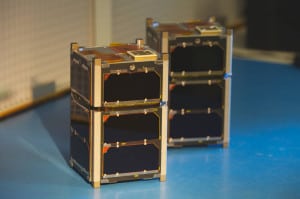Latest News
[Via Satellite 10-15-2015] NASA has awarded contracts to Firefly Space Systems, Rocket Lab and Virgin Galactic to provide Venture Class Launch Services (VCLS) for CubeSat missions to Low Earth Orbit (LEO). The awards will fund demonstration missions with dedicated SmallSat launch vehicles from each company, with a deadline of conducting the launch by April 2018.
VCLS constitutes NASA’s smallest class of launch services. The agency anticipates having a regular need for launches of small satellites in the future. Rather than build launch vehicles for this purpose, NASA chose to purchase launch services from industry in order to support greater commercialization in the launch sector while lowering its own costs.
“Traditionally when the government brings a new capability forward, it’s something that the government puts money out to try to develop. Here, because of that emerging commercial capability, that emerging market, there’s private investment backing the non-reoccurring development costs for these rockets. Traditionally, that represents 10 to 20 times an initial upfront cost of what you see for what we pay for a launch service. The government doesn’t have to foot that bill today,” Mark Wiese, chief of the flight projects office for NASA’s Launch Services Program (LSP), said Oct. 14 during a NASA press conference.
NASA has conducted 10 missions through its Educational Launch of Nanosatellites (ELANA) program, tallying a total of 41 CubeSat missions. Garrett Skrobot, NASA lead for ELANA, said the program has five more missions to fly over the next 13 months for 14 CubeSats, and through VCLS can now name missions 19, 20 and 21. ELANA has more than 50 un-manifested CubeSats waiting in LSP’s CubeSat Launch Initiative (CSLI) that can now find rides to orbit over the next three years.
NASA’s Earth Science Division within its Science Mission Directorate has partnered with LSP to fund the VCLS contracts. Wiese said NASA evaluated the winners based on their ability to balance cost with capabilities. Each was required to provide a systems requirements review level package so the agency could understand how mature they were in their development, since none of the awardees have yet launched their rockets.
Rocket Lab received the largest award at $6.95 million. The company, based in Los Angeles, Calif. with a launch site in New Zealand, is developing the Electron rocket, which can lift roughly 150kg to a 500km sun synch orbit, or a few hundred kilograms to a LEO elliptical orbit, according to Peter Beck, CEO of Rocket Lab. He said NASA’s demonstration mission will be on Electrons fifth flight, slated for either late 2016 or early 2017.
Firefly was the next largest recipient at $5.5 million. The company’s first vehicle, Firefly Alpha, is designed to carry 400kg to a 400km equatorial orbit or 200kg to a 500km Sun-synchronous orbit. Maureen Gannon, VP of business development for Firefly, said the company plans to start a series of suborbital test flights from Kennedy Space Center in 2017 through an agreement with Space Florida. Orbital missions are to follow in 2018.
Virgin Galactic’s award totaled $4.7 million for LauncherOne, an air-launched rocket capable of lifting 300 to 500kg to LEO. After recently scaling up the payload capability of LauncherOne, Virgin Galactic began looking for a new carrier aircraft, since the upgraded launch system outgrew WhiteKnightTwo. The company recently completed a 90-second hot firing of LauncherOne’s NewtonThree main rocket engine, and opened a manufacturing facility in Long Beach, Calif. earlier this year.
The amount paid for NASA’s demo VCLS missions all vary notably from the advertised price for each rocket. Firefly Alpha’s typical price tag is $8 million, Rocket Lab’s Electron is $4.9 million, and LauncherOne is described as below $10 million. Weise said the pricing reflects NASA’s willingness to bet early on launch systems that have yet to fly. Both Gannon and Virgin Galactic president Steve Isakowitz confirmed the lower price for their vehicles reflected NASA’s heightened risk tolerance with the demonstration missions. Beck said that Rocket Lab’s price was higher because Electron will be fully commercial by the time of the mission, and NASA’s mission includes some extra requirements over the company’s standard commercial mission. He added that Rocket Lab’s manifest is fully booked out to mid-2018.
“The CubeSats represent that high risk-tolerant payload, which are perfect for a demonstration of a first flight,” explained Weise. “So from the launch services program perspective we are along for the ride with low risk tolerant, high value spacecraft. This time we are trying to step back a little bit and make sure the government gets out of the way, and doesn’t inhibit the commercial solutions these companies are trying to bring forward, but we are going to definitely get insight so that when we do go forward and try to procure a launch service for a low risk tolerant spacecraft, we are one step ahead of the game in trying to certify them to make sure they can get us safe access to space.”
Get the latest Via Satellite news!
Subscribe Now